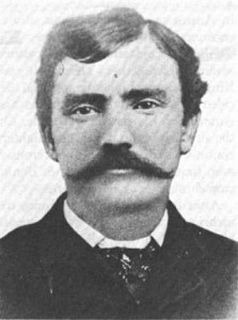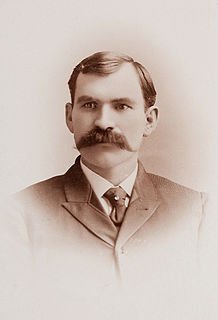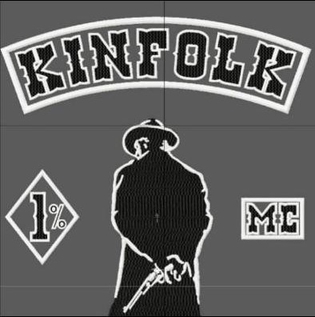
The Texas Ranger Division, commonly called the Texas Rangers and also known as "Los Diablos Tejanos"—"the Texan Devils", is an investigative law enforcement agency with statewide jurisdiction in Texas, based in the capital city of Austin. Over the years, the Texas Rangers have investigated crimes ranging from murder to political corruption, acted in riot control and as detectives, protected the governor of Texas, tracked down fugitives, and functioned as a paramilitary force at the service of both the Republic (1836–1845) and the state of Texas.
George Scarborough was a cowboy and lawman who lived during the time of the Wild West. He is best known for having killed outlaw John Selman, killer of John Wesley Hardin, and for his partnership with lawman Jeff Milton, with the pair bringing down several outlaws during their time together.

William Doolin was an American bandit outlaw and founder of the Wild Bunch, sometimes known as the Doolin-Dalton Gang. Like the earlier Dalton Gang alone, it specialized in robbing banks, trains, and stagecoaches in Arkansas, Kansas, Indiana, and Oklahoma during the 1890s.

Leander Harvey McNelly was a Confederate officer and Texas Ranger captain. McNelly is best remembered for leading the "Special Force", a quasi-military branch of the Texas Rangers that operated in south Texas in 1875–76.

Francis Augustus Hamer was an American law enforcement officer and Texas Ranger who led the 1934 posse that tracked down and killed criminals Bonnie Parker and Clyde Barrow. Renowned for his toughness, marksmanship, and investigative skill, he acquired status in the Southwest as the archetypal Texas Ranger.

John King Fisher was a gunslinger from the U.S. state of Texas during the heyday of the American Old West.

John Henry Selman was sometimes identified as an outlaw and sometimes a working lawman of the Old West. He is best known as the man who shot John Wesley Hardin in the Acme Saloon in El Paso, Texas, on August 19, 1895.
The San Elizario Salt War, also known as the Salinero Revolt or the El Paso Salt War, was an extended and complex range war of the mid-19th century that revolved around the ownership and control of immense salt lakes at the base of the Guadalupe Mountains in West Texas. What began in 1866 as a political and legal struggle among Anglo Texan politicians and capitalists gave rise in 1877 to an armed struggle by ethnic Mexican and Tejano inhabitants living on both sides of the Rio Grande near El Paso against a leading politician, who was supported by the Texas Rangers. The struggle reached its climax with the siege and surrender of 20 Texas Rangers to a popular army of perhaps 500 men in the town of San Elizario, Texas. The arrival of the African-American 9th Cavalry and a sheriff's posse of New Mexico mercenaries caused hundreds of Tejanos to flee to Mexico, some in permanent exile. The right of individuals to own the salt lakes, which had previously been held as a community asset, was established by force of arms.

Jeff Milton was an Old West lawman and the son of the Confederate Governor of Florida, John Milton. Jefferson Davis Milton, a descendant of the Milton family that produced the English poet, John Milton, was the first officer appointed in the U.S. Immigration Service Border Patrol in 1924.
The Jesse Evans Gang, also known as The Boys, was a gang of rustlers and robbers led by outlaw and gunman Jesse Evans, which lasted from 1876 until 1880. The gang was formed after Evans broke with the John Kinney Gang. After breaking away, he brought along with him Billy Morton, Frank Baker, Tom Hill, Dolly Graham, George Davis, Jim McDaniels, Buffalo Bill Spawn, Bob Martin, Manuel "Indian" Segovia and Nicholas Provencio.

Ernest "Diamond Dick" St. Leon was a French-American law enforcement officer and a member of the Texas Rangers, known prominently during the 1880s as one of its finest undercover officers. He received the nickname "Diamond Dick" from his fellow officers due to his habit of wearing diamonds on his uniform.
Tom Threepersons was an American lawman. He is considered to have been one of the last of what were considered gunfighters of the Old West, although his career did not begin until the early 20th century. He invented the "Tom Threepersons holster."

John Reynolds Hughes was a Texas Ranger and cowboy of the Old West, and later an author. Several books were written about his long history as one of the most influential Texas Rangers of all time. It has been suggested he was the inspiration for the Lone Ranger character, since Zane Grey dedicated The Lone Star Ranger to Hughes in 1915. The ambush of Texas Ranger Captain Frank Jones and Hughes' long hunt for the killers also support this theory. Hughes also told relatives that he believed he was the inspiration for the Lone Ranger character.
Lon Oden was a Texas Ranger of the Old West, and is a legend inside the Texas Rangers organization.
The origins of today's Texas Ranger Division trace back to the first days of Anglo-American settlement of what is today the State of Texas, when it was part of the Province of Coahuila y Tejas belonging to the newly independent country of Mexico. The unique characteristics that the Rangers adopted during the force's formative years and that give the division its heritage today—characteristics for which the Texas Rangers would become world-renowned—have been accounted for by the nature of the Rangers' duties, which was to protect a thinly populated frontier against protracted hostilities, first with Plains Indian tribes, and after the Texas Revolution, hostilities with Mexico.

My Outlaw Brother is a 1951 American Western film directed by Elliott Nugent, produced by Benedict Bogeaus, and starring Mickey Rooney, Wanda Hendrix, Robert Preston and Robert Stack. Filmed in Mexico and released through Eagle-Lion Classics, the picture is based on the book South of the Rio Grande by Max Brand and is sometimes referred to as My Brother, the Outlaw.

The Battleground Gunfight, also known as the Battleground Shootout, was a gunfight between a posse of American lawmen and the Smith Gang. It was fought on October 8, 1901, within Arizona Territory's Fort Apache Indian Reservation, at a clearing in the forest known today as the "Battleground". Nine Arizona Rangers and deputies caught up with the cattle rustler Bill Smith and his gang. During a long exchange of gunfire that followed, Ranger Carlos Tafolla and Deputy Bill Maxwell were killed and one or two of the outlaws may have been wounded. In the end, the Smith Gang escaped the posse and fled into Mexico.
The Smith Gang was a band of American cattle rustlers who operated in the Southwest during the late 1890s to 1901. The gang was founded by Bill Smith and included six others, mainly Bill's family members. After an encounter with the law in Arizona Territory, known as the Battleground Gunfight, the Smith Gang was forced to escape to Mexico in October 1901.

The Kinfolk Motorcycle Club are an American one-percenter outlaw motorcycle club best known for their longstanding rivalry with the Bandidos Motorcycle Club. The club was formed in Texas and has around four chapters within the Southern United States.













